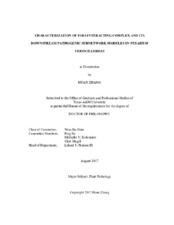| dc.description.abstract | Fusarium verticillioides is an ascomycete fungus responsible for stalk and ear rots of maize. Previously, we identified a striatin-like protein Fsr1 that plays a key role in stalk rot pathogenesis. In mammals, striatin interacts with multiple proteins to form a STRIPAK (striatin-interacting phosphatase and kinase) complex that regulates a variety of developmental processes and cellular mechanisms. In this study, we identified the homolog of a key mammalian STRIPAK component STRIP1/2 in F. verticillioides, FvStp1, that interacts with Fsr1 in vivo. Gene deletion analysis showed that FvStp1 is critical for F. verticillioides stalk rot virulence. In addition, we identified three proteins, designated FvCyp1, FvScp1 and FvSel1, that interact with the Fsr1 CC domain by yeast-two-hybrid screen. Importantly, FvCyp1, FvScp1, and FvSel1 co-localize to endomembrane structures, each having preferred localization in the cell, and they are all required for F. verticillioides virulence in stalk rot. Moreover, these proteins are necessary for proper localization of Fsr1 to endoplasmic reticulum (ER) and nuclear envelope. To further characterize genetic networks downstream of Fsr1, we performed RNA-Seq with maize B73 stalks inoculated with wild type and fsr1 mutant. We used a computationally efficient branch-out technique, along with an adopted probabilistic pathway activity inference method, to identify functional subnetwork modules likely involved in F. verticillioides virulence. We identified two putative hub genes, i.e., FvSYN1 and FvEBP1 identified from the potential virulence-associated subnetwork modules for functional validation and network robustness studies, such as gene knockout, virulence assays and qPCR studies. Our results provide evidence that FvSYN1 and FvEBP1 are important virulence genes that can infulence the expression of closely correlated genes, providing evidence that these are important hub genes of their respective subnetworks. Further characterization of FvSYN1 showed that FvSyn1 is important for regulating spore germination and hyphal morphology. Furthermore, FvSyn1 is localized to vacuoles, plasma membranes, and septa, and has been shown to play a role in the response to cell wall stressors. Motif-deletion studies showed that both N-terminal SynN domain and C-terminal SNARE domain of FvSyn1 are required for pathogenicity but dispensable for fumonisin production and sexual mating. | en |


